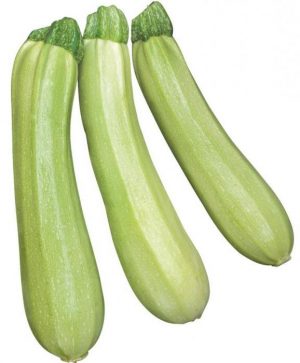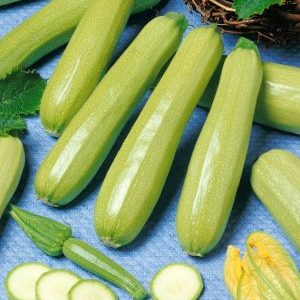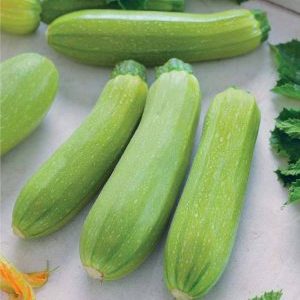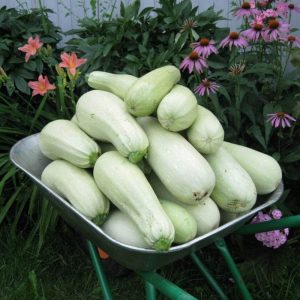Zucchini variety "Cavili" from Dutch breeders: what you might like and how to grow it correctly
Zucchini is an unpretentious horticultural crop with a delicate taste and high nutritional value. Many summer residents prefer varietiesthat require a minimum of maintenance and give a rich harvest. In this regard, the Cavili f1 hybrid from Dutch breeders has proven itself well.
The content of the article
Description
The Cavili squash forms a compact shrub with an erect stem. Curly leaves grow on long stalks. The leaf plate is painted with characteristic whitish spots. The flowers are large, orange. Fruits of regular cylindrical shape with a faceted surface and smooth light green skin.
F1 hybrid

The hybrid Cavili f1 took the best characteristics of the parent varieties. It belongs to self-pollinated crops. Male flowers form on the bush, but do not play a physiological role. The fruits appear on their own, even during rainy periods when the bees do not fly.
The yield on the bushes is stable, all fruits are of the same size and shape. The main advantage of the Cavili f1 hybrid is its high immunity to fungal diseases.
Origin and development
Cavili hybrid of Dutch origin. Zucchini was approved for cultivation throughout Russia in 2002 and is included in the State Register.
Distinctive features
Gardeners especially appreciate the Cavili f1 zucchini for a number of advantages:
- self-pollination ability;
- a small number of seeds in fruits;
- long fruiting period;
- drought resistance and disease resistance;
- the possibility of growing in a greenhouse.
Experienced farmers choose hybrid plants for commercial production.
On a note! 2-3 Kavili f1 squash bushes fully cover the needs of a family of 4-5 people for the season and for preparations for the winter.
Fruit characteristics, yield
The fruits of the hybrid are even, of the same shape, with a thin skin. The length at the time of market ripeness reaches 18-20 cm, weight 300-400 g. The pulp is dense, juicy, delicate in taste. The first zucchini is harvested 35-40 days after germination, 7-10 days after the formation of the ovary.
The expected yield per bush, subject to the rules of agricultural technology, is 4-5 kg. The fruits tolerate long-distance transportation well.
How to grow
Zucchini - unpretentious culture, caring for it is simple, but certain secrets exist.
Planting by seeds or seedlings

It is impossible to obtain high-quality hybrid seeds while maintaining all the characteristics at home, therefore, planting material is bought in a store. Zucchini are grown in seedling and seedling methods from seeds.
Zucchini grows in well-lit areas with high-quality soil composition.
Before planting in autumn, the soil is brought to the desired state:
- peat, compost, superphosphate are applied to clay soils and loams;
- on sandy areas - peat, wood ash, mineral fertilizers;
- peat soils are loosened with sand, sawdust, wood chips, compost.
Seeds are planted after the soil warms up to +12 ° C. The holes are placed at a distance of 70-80 cm from each other, the recommended row spacing is 1.5 m. The optimum depth of the hole is 5 cm, 1-2 seeds are embedded in each. During the period of return frosts, the seedlings are covered with a cut plastic bottle.
On a note! The seeds of the Cavili hybrid are distinguished by good germination; they do not need to be soaked before planting.Seed material is sold already processed with the nutrient composition.
Zucchini seedlings are planted in the greenhouse in individual peat pots at the age of 10-12 days. Seedlings are planted in the first or second decade of March. With the appearance of the first flowers, the film is opened during the day, but covered again at night.
Care
Kavili zucchini care is standard. The root system of the bush is on the surface, therefore loosening is carried out to a depth of 5 cm in the area of the bush and 15 cm in the aisles. Weeds are removed as needed.
On a note! In the period when 4-5 leaves appear, the zucchini is slightly spud. This enables the root system to grow stronger.
The hybrid is not picky about moisture. Before the first buds appear, evening watering once a week is sufficient. In the phase of active ripening of fruits, the bushes are watered 2 times a week. The leaves of the squash are dense and large, after watering the plants do not need mulching. Zucchini does not tolerate sprinkling, water is poured under the root... Excessive moisture on the leaves can cause the development of fungal diseases.
The hybrid is classified as early ripening, so fertilizing with mineral fertilizers should be done very carefully. Excessive application of complex mineral fertilizers will lead to the accumulation of nitrates in the fruits. During the season, 1 top dressing will be enough during the budding period.
Fertilize zucchini like this:
- a shallow groove is raked off around the main stem;
- 0.5 l mullein and 1 tbsp. l. nitrophosphate is diluted in 10 liters of water;
- mix and insist for 10 minutes, pour under the root, rake in.
Zucchini growing in the open field, subject to crop rotation, do not feed.
Features of cultivation and possible difficulties

Zucchini are planted in open beds without shading in a place where pumpkin plants did not grow in the previous year. Zucchini grows best after crucifers, onions, and potatoes.
The soil for planting is prepared in the fall - they dig up and apply organic fertilizers. In the spring, the beds are leveled and seeds are sown.
The bushes are watered with exceptionally warm water in the early morning or at sunset.
When the yield decreases, the first 2-3 large leaves are removed to stimulate the flow of nutrients into the fruits.
Diseases and pests
The Cavili hybrid is immune to powdery mildew. But infection with other diseases is possible:
- Zucchini anthracnose - forms brown-yellow spots on leaves and stems, leads to decay of fruits. The disease attacks during hot, humid periods. The method of struggle is to remove the affected leaf, spraying with EM preparations.
- Root rot - bushes growing in the greenhouse are affected. The cause of the disease is excessive consumption of organic matter and high humidity. Adding 1 cup of wood ash per 1 m2 to the soil corrects the situation.
- Cucumber mosaic - the causative agents of the virus overwinter in the open field. The leaves are covered with yellow spots and curl, the bush dies. Aphids and ants carry the disease. The affected bush cannot be treated. Healthy plants are sprayed to kill aphids.
To combat aphids, insecticides are used - "Aktara", "Aktellik". When a spider mite appears, the plants are sprayed with onion infusion with the addition of red pepper and laundry soap.
Harvesting and application of the crop
The flesh of the zucchini is juicy, light green in color. Overripe fruits do not lose their taste, but it is better to harvest the crop on time. Ripe fruits on the bushes inhibit the formation of a new ovary and reduce the yield.
The hybrid fruit is suitable for universal use... They are fried, stewed, canning... If you collect fruits with a stem 2-3 cm long, the zucchini is stored in a cellar or refrigerator for 3-4 weeks.
Advantages and disadvantages of the variety

Gardeners prefer Kavili zucchini for a number of objective reasons:
- compact bush;
- ultra early maturity;
- good taste;
- powdery mildew resistance;
- long-term fruiting;
- drought resistance;
- self-pollination ability.
The Cavili F1 hybrid has one insignificant drawback - it is necessary to buy new seed every year.
Farmers reviews
Summer residents generally speak positively about this culture.
Ivan, 39 years old, Taganrog: “Kavili's pub was discovered 5 years ago. I grow in a greenhouse for sale about 20 bushes annually. They ripen early, care is minimal, they don't really need watering. The presentation is decent, I always take a photo of a bush for advertising. Two packages of seeds fully cover the cost of maintaining the dacha during the year. "
Marina, 29 years old, Moscow region: “I buy hybrid seeds in the spring with my neighbor in the country. One bag is enough for two people. The bushes grow beautiful, the leaves are fleshy and spotty. Does not burn in the sun, does not fade. The fruits are tasty, juicy, tender flesh, good for caviar. "
Petr Matveyevich, 62 years old, Oryol: “I plant the Kavili zucchini in March under plastic wrap in peat pots. In early May, we already eat our own fruits without nitrates. I fertilize exclusively with rotted manure, no chemicals. Zucchini are even, not twisted, the skin is soft, thin. For 3 years of cultivation, they have never been sick. "
Conclusion
Zucchini Kavili f1 gives a good harvest with minimal maintenance, is distinguished by its taste, and is self-pollinated. The only task of the summer resident when growing a hybrid is to carefully prepare the soil in the fall and prepare for long-term fruiting.
An extremely unsuccessful and undeservedly promoted variety. I planted it from 4 seed packers in different years. Lost money and space. I can't say anything positive. Our time-tested plants with 3-4 bushes give excellent yields and are wonderful in terms of quality (and most importantly, taste). Never again will I spend money on Kavili! They are poorly stored, the taste is mediocre .. Except for the blanks ... Moreover, they are capricious at the same time. Now they are cold, then they are hot. That flower rotted, then not tied, etc. At the same time, the price is prohibitive for the seeds of this hybrid - 50 rubles 5 (pieces). I don’t know what the Dutch have modified, perhaps they added jellyfish genes)).
Planted Cavili in 2020 and is terribly disappointed. Zucchini simply does not get worse - it grows poorly, the flowers are mostly male, the ovaries rot, fall off. The zucchini tastes watery and sour. I do not advise anyone.